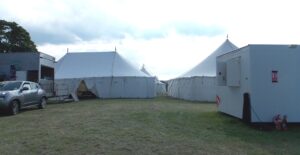
Photo of similar setup courtesy Acabashi, CC 4.0
A visitor last week to a major Hollywood film production was treated to a view of the food that gets an army of extras through 12 to 16-hour work days.
One hears self-referential stories and jokes in movies and on TV about “the craft table,” or “craft service,” as if it offers a bonanza in which to indulge and gain weight. At this set, “crafty” was a long folding table that held five-dozen kinds of snacks in individual packaging, such as salted peanuts, protein and granola bars, and popped rice or potato crackers. There were bananas, bottled or canned water, hot tea and coffee. No soda was served. Sometimes a couple of kinds of candy bars appeared, or a small selection of potato or corn chips. Any extra could have gone up any time they were in the holding tent and received endless amounts of snacks for free, but no one did, and the choices were generally healthy. Due to COVID, everything had to be handed to them by a craft service attendant.
The film production had sent notice to the 170 extras before shooting began that the serving of food, and its consumption, would be different in the age of COVID. They were warned there would be no buffet line for the (free) hot meals catered twice a day. The production also warned that mask and distancing rules would be strictly enforced, that no one would be allowed to sit closer than six feet, and there would be a strict limit on the number of those eating at once.
In reality, a hot breakfast was served every morning from a buffet line; it was just that there was no self-service, and those in line had to be masked. Any or all extras present were served at the same time and allowed to sit as they wished at long tables. They often chatted for hours in tight groups, though it was in a drafty catering tent, and masks were required to walk around.
An actor friend, who was in a John Hughes movie back in the day and has spent countless hours on commercial and indie-film sets more recently, says catered meals used to be cheap—often just pasta—and everything was smothered in cheese. This was different.
Granted, breakfast was served from a long line of sterno-ed trays that held scrambled eggs, biscuits, gravy, hash browns, pork sausage, breakfast sandwiches wrapped in foil, small ham and egg burritos, pancakes, French toast, and muffins. But the heartiness was welcome in the cold, and one could always skip a meal or eat only a fruit cup if they liked.
Hot lunches, however, were a choice of four lean proteins that came with relatively plain sides. A day’s selection might be white fish, pork loin, chicken filet, or vegan, served with white rice, black beans, and steamed carrots. Often the serving of protein looked small but turned out to be filling. Side salads with a choice of dressing sat on ice nearby, next to containers of milk, and small squares of cake. Coolers with taps held sweet southern or unsweetened tea and lemonade.
The lunch meal, served at 2:00 pm, was already in cardboard clamshells and tepid, but the extras said it beat waiting in line to be served. The chicken and beef were often tough, but the pork was tender and tasty, and the fish well-cooked. Extras spoke with amusement about professional extras on other sets who came with Tupperware to take food home to live on. On this set, large paper bags with handles were provided for taking home leftover food, which one background actor said he fed to his dogs.
The production also provided recycling bins that filled and were emptied quickly; the bins had dedicated minders to help people separate items properly.
Extras on this production earned $11 an hour—time-and-a-half for overtime, which happened every day—but the food value was significant, and there were few complaints.
